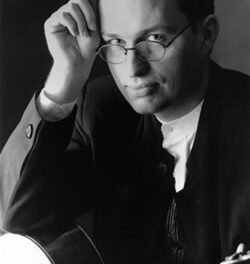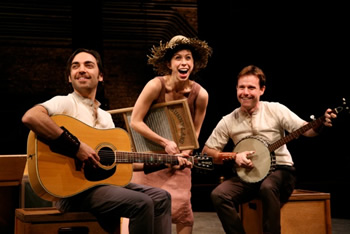George Gershwin, Porgy & Bess; Jonathan Lemalu, bass-baritone, Isabelle Kabatu, soprano, other soloists, Arnold Schoenberg Chor, Chamber Orchestra of Europe, Nikolaus Harnoncourt, cond.; SONY Music RCA Red Seal 88697591762, ©2009, TT 175:51, $24.98.
This is another ‘occasional’ CD, commemorating two occasions: the 75th anniversary of the NYC première of the work on 10 October 1935, and the conductor’s 80th birthday (b. 6 December 1929). When SONY asked Harnoncourt what he would like to do to mark the latter, he said he’d like to issue a recording of the version of Porgy & Bess that he had presented at the Graz (Austria) Festival in early 2009.
To the casual listener/observer, it might appear to be quite a leap for a German musician (he grew up in Graz) who spent much of his career as an early-music/historically-informed-performance cellist (he founded Concentus Musicus Wien in 1953) to tackle a nearly mid-20th century American classic. But when you think about it and read his comments and notes, you realize that he approached the project in precisely the same way that he did all of his other period performances: trying to find all the available documents and ascertain the composer’s intentions in order to remain faithful to them in his interpretation. As with many historically informed performances, the result is something quite different from the performances that we have become accustomed to hearing, the Broadway musical style one in this case.
Harnoncourt discovered documentary evidence that Gershwin set out to write an opera and did a lot of things to prepare himself for something that he had never previously attempted. He went to Cuba to study Caribbean music, to Charleston, SC, to study the dialect and milieu, and to Europe in 1928 to study the roots of classical music, first to Paris, where he met Ravel and Stravinsky, though neither took him under his wings, and took some lessons from Nadia Boulanger. Then he went on to Vienna where he met Alban Berg, with whom he hit it off better, and who gave him a copy of the score of his Wozzeck (US première in Philadelphia under Leopold Stokowski in 1931). There are numerous similarities – Harnoncourt refers to “parallels,” both obvious and subtle, between the two works. He views Porgy and Bess as the first genuine American opera that used the modern idiom then current. Christopher Reynolds refers to it in a 2007 study of the score in the Journal of the Society for American Music as “an American Wozzeck.” Gershwin himself viewed the work as combining opera with theatre, mixing genres as he was often wont to do.
Harnoncourt chose to attempt to construct the ideal or optimal version of the work based on the NYC première version, using the autograph full score, vocal scores, and transcripts of discussions among the members of the creative team, rather than to replicate that performance. The preceding Boston première was four hours long, so it needed to be cut, and Gershwin made those eliminations, and some additions of new material as well, in collaboration with his librettists (Ira Gershwin and [Edwin] DuBose Heyward, the author of the 1925 novel Porgy, and subsequent 1927 play of the same title co-authored with his wife Dorothy, on which the opera is based) and director-producer Rouben Mamoulian (who had also directed the play) prior to the NYC opening. (Maazel first presented this version in Cleveland in 1976; other performances followed around the country, including in NYC.)
For most of the productions following the composer’s 1937 death, beginning with the 1942 revival, the work was further cut and twisted to conform to the Broadway musical model. The Berg-like recitatives were converted to spoken lines; tempo markings were all changed. A more operatic version in two acts was crafted in 1952 that also toured Europe, Latin America, and the Middle East with another NYC run in between that initially starred William Warfield and Leontyne Price (who met and married during the run), but many recitatives and several characters remained omitted.
Many previous recordings, beginning with the 1952 one under the baton of the conductor of the NYC première, Alexander Smallens, and the 1959 Otto Preminger film (Mamoulian had initially been engaged to direct it, but was fired when he suggested filming on location in Charleston after the Hollywood set burned.) offered either that Broadway musical type of interpretation, or offered only excerpts – the complete soundtrack was never issued. The composer’s original intentions, of which Smallens was well aware, were not respected in his recording. Recordings were made of the 1976 Maazel performance and a similar 1977 one in Houston; both won Grammy awards. The 1989 Glyndbourne recording also presents the uncut version. John Mauceri, current chancellor of UNCSA in Winston-Salem, conducted the Nashville Symphony Orchestra in a version similar to this one in a 2006 recording.
The form of the work in this incarnation is, for my ears, infinitely more pleasing and satisfying than the Broadway musical version I had been accustomed to hearing, even though the conclusion of Act III seems to lean more in that direction than all that precedes it. The performance is very committed and convincing. The singers, who, although they have appeared in the US, may not be familiar to the majority of American listeners – Lemalu is a New Zeeland-born Samoan, Kabatu is Belgian of African origins – are outstanding and seem authentic in their diction. One senses the spirit of what action there is. A unique feature of this performance is the “Symphony of Noise” that opens Act III, scene 3. Gershwin specified that this orchestral interlude, following a brief composed introduction, was to be an improvisation left to the discretion and imagination of the music director – he had personally selected, and therefore trusted Mamoulian. Harnoncourt located a verbal description of the one from the NYC première and reconstructed it (CD 3, track 7) from that, using genuine African instruments for the specified “African drums.” It pleasingly and successfully evokes sounds of nature preceding those of the commencement of human activities as dawn breaks on Catfish Row. The sound quality of the recording is superb; it is not readily apparent that this is a recording of an actual performance.
The booklet provides cast details, track listings and timings, excerpts from an interview with Harnoncourt, notes by him and by Josef Beheimb, a synopsis, and the libretto, all in English and German (original). There are a few linguistic errors in the English translation: “quietened” for “quieted,” for example – doesn’t anyone engage proofreaders anymore? Bios of the singers would have been welcome. There are two black and white photos, one of Harnoncourt and the cast, the other of the title character stars. Collages of color photos from the performance adorn the outside of the front and back tray cards and are duplicated on the box. It is not a lavish production, which probably helps keep the price down, but the quality is high. We are fortunate that SONY granted Harnoncourt his birthday wish! If you are a Gershwin or Porgy fan, you should give yourself this recording for your birthday (or any or even no occasion)!
Marvin J. Ward













